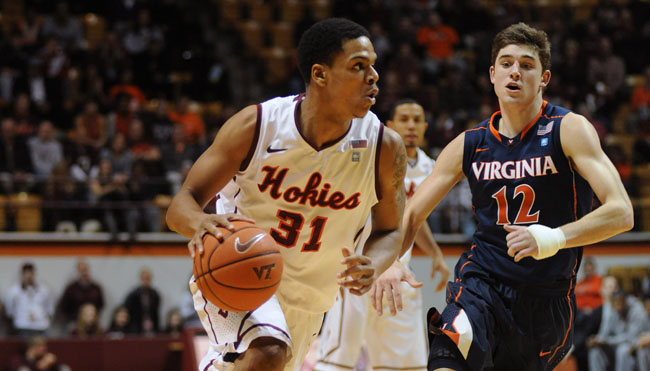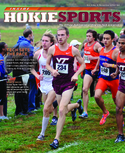
When Virginia Tech AD Jim Weaver was forced to find additional nonconference football games starting next year, there were plenty of factors to consider – the financial implication of a new series, finding an attractive opponent for fans and for television, and the strength of schedule component that will be part of college football’s new postseason format beginning in 2014.
Oh, and he had to consider things like density altitude (* see below) and runway length.
Weaver announced that Tech would renew its series with East Carolina, an eight-game series that goes through the 2020 season, but few knew that the Roanoke airport – and its limitations – were a factor in his decision-making process.
“ECU is an attractive opponent because Greenville is close for our fans, particularly those in the eastern part of the state (** see below),” Weaver explained. “ECU fans also come when the game is in Blacksburg and buy tickets here. And third, quite frankly, we don’t want to bus to Greensboro to fly to the West Coast to play a football game. We can’t fill up a plane with all our people, and all our gear and fly out of Roanoke.”
You’ve heard that similar statement from Weaver and other Tech officials for years, but to get the actual scoop on the Roanoke Airport and how it affects the Hokies and nonconference football scheduling, I turned to aviation expert Tom Bibbins of Blacksburg. Following a 10-year career of flying fighter jets in the U.S. Navy, Bibbins spent 30 years with US Airways, flying 737’s, 757’s, and Airbus passenger aircraft around the country and the world.
So what’s the deal, Tom?
“Each airport and capability of aircraft is different because of the density altitude and the temperature,” Bibbins said. “In Roanoke, you have 1,200 foot of altitude and just over 6,000 feet of runway. Greensboro is different because of the elevation and the length of the runways.
“Lift and engine performance are impacted by density altitude. And in Roanoke, the fuel we can put on a plane to fly a long distance is a factor. Fuel weighs 6.7 pounds per gallon, and you can get about 26,000 pounds of fuel on a 737 and about 48,000 pounds on a 757.”
That’s a lot of jet fuel.
“Yes, but you can’t fill it with fuel and 150 people and all that gear and fly to the West Coast out of Roanoke,” Bibbins said. “Any flight over two or 2.5 hours can’t be done because of the altitude and the length of the runway there. You simply can’t fill the plane with fuel.”
UPS flies large aircraft in and out of Roanoke each day, but Bibbins pointed out that those planes are only flying to Greensboro or Louisville, which are very short flights – about 17 minutes to Greensboro and 45 to Louisville – that require little fuel.
For a jet filled with passengers, gear, and fuel, safety is the issue, as well as the simple laws of physics.
“You have what’s called a ‘stop-go’ distance, or ‘V-1’ where you either have to pull it off the ground or stop [the plane]. The V-1 in Roanoke is much shorter,” Bibbins said. “You also have the second-segment climb in Roanoke over the hills, and the climb rate is factored in as well.”
The bottom line: “You can’t take an entire football team a long distance out of Roanoke,” Bibbins said.
Are there any circumstances where it could be done?
“If the temperature was under 59 degrees and the conditions were perfect, then maybe,” he said. “But when you have high density altitude and high temperatures, you need a longer runway, and your rate of climb is impacted. That’s an issue when you have mountains around an airport, like Roanoke.”
So a flight to Boston or Miami or Greenville, N.C., is fine for Tech or any opposing team trying to fly in or out of Roanoke. Anything longer than say three hours is problematic, regardless of how big the plane is.
Just another factor administrators consider when making their nonconference schedules.
To read more on how density altitude and high temperatures can affect your commercial flights, you’ll enjoy this story: http://www.lasvegassun.com/news/2012/jul/11/why-extreme-heat-makes-life-more-difficult-airline/
(Notes from above)
*This isn’t an aerodynamics report, but as density altitude increases, the molecules of air decrease. And as Mr. Ober in 10th grade physics class explained, a reduction in air density reduces a wing's lift. That’s bad news for a plane because, if there is less air flowing over the wings, it needs longer to take off (a longer runway) and has a reduced climb rate (not good when there are mountains). When it’s really hot and humid, the density altitude gets even higher. That reduces engine performance, and for a pilot, turns Roanoke into … well, Aspen.
** It’s also attractive because of the barbecue joints in town. B’s and Parker’s top the list.
Hite has seen it all
It’s been a tough season for Tech’s football team, and especially for Billy Hite, the longtime Tech assistant who is serving as senior advisor to head coach Frank Beamer. After 34 years on the Tech coaching staff, Hite assumed his new role in 2011.
“No, I didn’t expect this team to have this type of season,” Hite said. “We’ve made some mistakes, but we’ve also had a lot of bad bounces. Back in 1999, when we went undefeated, it seemed like we got some breaks and some calls, and things went our way in close games. This year, it’s the opposite. We’ve had turnovers at the worst possible times, and we’ve seen the other team get a bounce here or there.”
Tech’s inability to run the football consistently has been disappointing for a guy who coached 28 backs at Tech who signed with NFL teams.
“I watch these guys, and they’re going to be good,” Hite said. “Michael Holmes can be special, but they’re all just young right now. They’re just learning what they need to do, and it doesn’t happen as fast as we’d like, or anyone would like.”
The impact of losing three straight running backs early to the NFL – Darren Evans, Ryan Williams and David Wilson – is a factor here, according to Hite.
“You’ve got to assume, in recruiting, that everyone at that position is going to leave early and just try to sign a great one each year,” he said. “It’s a factor because high school kids don’t want to sit. They want to play. So in recruiting, you’ve got to assume that [after a junior season] you’re losing your better players anyway.”
It’s been tough for Hite – and Hokie fans everywhere – but he says brighter days are ahead.
“We just got caught with too many young players playing key positions at the same time,” he said. “But we’ll be better. No doubt about it.”
Hoops Busy Early
James Johnson’s basketball team will play six games in November and then a busy December takes the team from Morgantown to Las Vegas to Salt Lake City.
“It’s a busy schedule, and we’ll adjust our practice time a bit – shorter practices with just eight scholarship guys,” he said. “We’re not going to change the way I want us to play, which is fast. But we don’t want to wear them out in practice.”
Tech played two exhibition games – at home against Ohio University and at South Carolina – and senior point guard Erick Green stood out in both. Green was amazingly consistent last season, scoring in double figures 30 times in 31 games. He should have a terrific season, but don’t be shocked if Jarell Eddie really takes a gigantic step forward during his junior year.
Why? First, he’s in the best shape of his career and has developed a better floor game. Plus, like Robert Brown, he’ll be freed up to shoot a bit more this season. Tech’s big guys, C.J. Barksdale and Cadarian Raines have also improved, and freshman Marshall Wood has added about 14 pounds since his arrival to campus. He’s a solid 6-foot-8, 225 now and getting bigger, which is encouraging.
This Tech team should be able to score despite its lack of depth. However, since joining the ACC, the Hokies never finished higher than seventh in the conference in scoring and saw their scoring numbers drop dramatically over the past couple of years. Last year, the Hokies didn’t score 70 points in regulation time during a single ACC game and averaged just 65.1 points per game.
YEAR PPG ACC Rank
2005 68.5 11th
2006 68.7 10th
2007 71.5 10th
2008 70.2 11th
2009 72.6 8th
2010 72.7 7th
2011 70.3 7th
2012 65.1 8th
The question will be can the Hokies defend in the post, and can they defend on the perimeter without getting into foul trouble.
“I have to learn about my team and see who can play with two fouls or three fouls,” Johnson said. “You’re not going to play if you don’t guard well and play tight defense. We need to be able to guard well without fouling.”
For a guy like Eddie, who averaged one foul every 8.9 minutes last year, this will be an interesting season. Eddie was forced to play power forward and that was an issue on the defensive end because of his size (6-7, 218). He is one guy to watch during the first 10 or 15 games of this season at both ends of the floor. We know he can shoot. Can he guard a small forward consistently?
The bottom line is this: Tech should average more than 70 points per game this season. It should be a very fast-paced fun team to watch. If the Hokies can guard well enough, particularly in the post, they should be in for a fun season.




